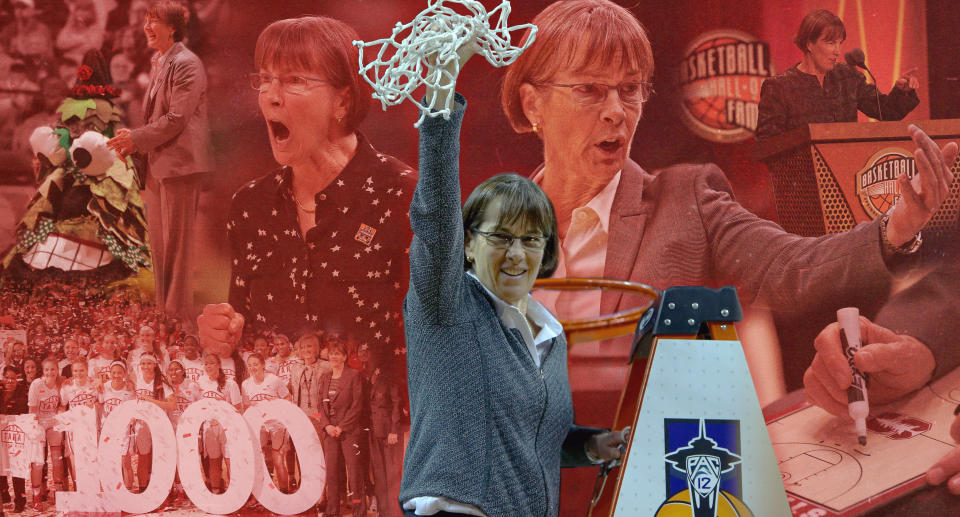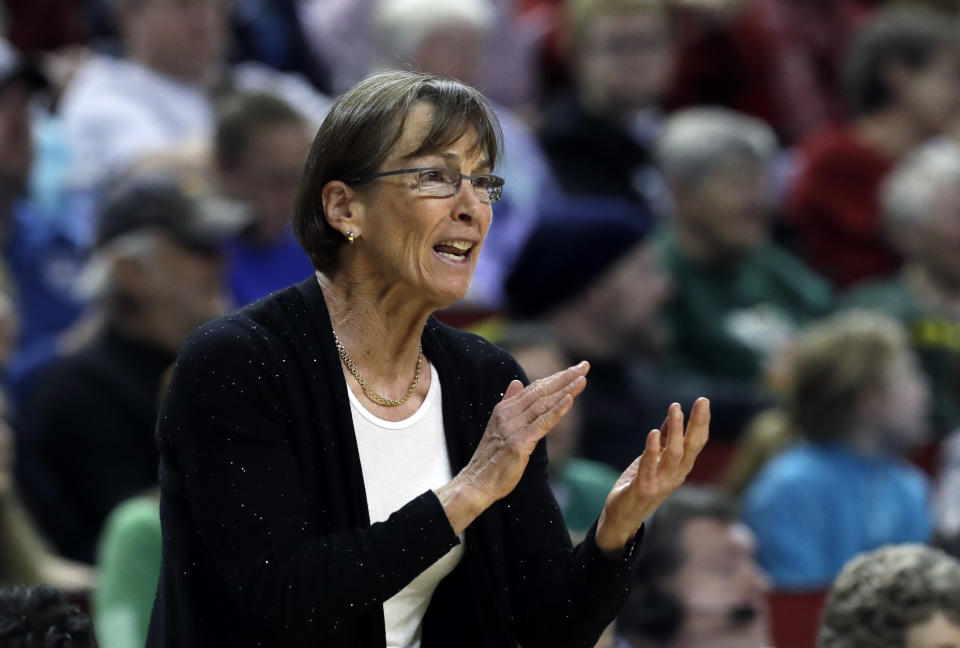Stanford coach Tara VanDerveer warns that laws like SB 206 still won't fix gender pay gap

The current Stanford Cardinal roster has never known a world in which the USA Basketball women’s national team didn’t hold Olympic gold. It’s also never known a world in which Stanford wasn’t in the tournament.
Both of those truths can be attributed in part to Tara VanDerveer, who began her 34th season as No. 3-ranked Stanford’s head coach last week by preparing her squad for an exhibition against the U.S. It was VanDerveer who in 1995 first started a national tour against collegiate squads and brought gold back to the U.S. as coach at the 1996 Atlanta Olympics.
Since then, the U.S. has rattled off six consecutive golds. Stanford has extended its streak to 31 consecutive winning seasons and a total of 12 NCAA Final Four appearances with two NCAA titles (1990, ’92). Nearly 40 Cardinal players have been appointed to national teams.
Yet as far as both squads have come in nearly a quarter-century, VanDerveer told Yahoo Sports she still sees further to go from parity in competition to profiting off one’s likeness.
SB 206 won’t ‘be a windfall’ for female athletes
In a few years, Stanford athletes will benefit from SB 206, the California bill that will allow college athletes to profit off their likenesses. It has spawned debate with the Pac-12 including in its argument the bill will “have a negative disparate impact on female student-athletes.”
The conference got immediate pushback for using women and Title IX as a shield. And while VanDerveer isn’t against the bill, she does want to quell any exuberance by female athletes that this will be as life-changing for them as for their male peers. It’s not that she wants it to be that way. It’s that the woman who was in college herself when Title IX passed grasps the reality. She’s cautious.
“I’m just hoping that women won’t be left in the dust,” VanDerveer said. “There’s a lot of disparity between what men and women are paid in sports. There’s one woman in the top 100 in terms of income. That’s Serena Williams.
“I think it’s a little, maybe, misleading for female basketball players to think, ‘Oh, this is going to be a windfall for us,’” she said before a heavy pause. “I don’t think it will be.”
As for the entire idea of the law, she’s all for it. She doesn’t believe athletes should be used, she said, but she does want to remind people that they are getting something out of it that puts them a step ahead already.
“First and foremost, a full scholarship at Stanford is a very, very valuable thing,” she said.
VanDerveer stressed the value of any college education, a conversation that is a shade different in women’s college basketball than in football or even men’s college basketball. The current WNBA collective bargaining agreement, which expires at the end of 2019, does not allow early entry; players must play four years or be age 22 the calendar year of a given draft to be eligible. It means that most players get their undergraduate degrees, or come incredibly close, and then use them afterward.

VanDerveer wants it to be a deeper sport
It’s been 24 years since VanDerveer took a sabbatical from Stanford to lead Team USA. The following year, the WNBA launched off the national team’s success and women’s players became household names as the sport grew in prominence at every level.
Some did that better than others.
“I think when you look at some of the very top teams [in college] and you look at the scores of the games, we want to be a deeper sport,” VanDerveer told Yahoo Sports. “We want all teams to be somewhat competitive. We have a ways to go in terms of parity — not maybe [in the] top 20, top 30 or so, but developing all the way through Division I, all [349] teams. You’re always going to have some teams that are better than others. But really we want to have a deep, competitive field throughout.”
She wants to see female athletes given equitable access to nutrition, training and the weight room at all levels of play. And though she recognizes it’s unpopular, another answer might be to drop the number of scholarship spots for each team from 15 to 14 to spread out top talent to more teams.
“Just so that one extra person goes somewhere else,” she said.
Stanford’s freshman class is ranked No. 2 by ESPN and consists of Haley Jones (ranked No. 1 overall), 6-foot-5 post player Ashten Prechtel (15), dunk sensation Francesca Belibi (19) and point guard Hannah Jump (50). South Carolina is ranked first with five players, four of whom are ranked in the top 11.
They join already strong rosters with juniors and seniors who were also toward the top of their recruiting classes. Stanford star junior Kiana Williams was the ninth-ranked recruit in 2017 and the class ranked fifth. Decreasing the number of scholarships would force the players at the higher end of the top 100 to choose programs beyond the top 20 every cycle.
Stanford’s defensive commitment will determine season
Health is No. 1. That’s a given for any team. Outside of that, it will be the defensive presence, especially by the freshmen, that VanDerveer said will determine a deep tournament run.
“Because we’re counting on so many young players, in terms of on the court, I think it’ll be the development of our defense,” VanDerveer said. “Just how committed at the defensive end will our young players be. Can they really dig down and really guard people and be able to make the plays when we need them to make the play?”
VanDerveer said she was impressed by the freshmen against the U.S. and found humor in their jump from high school to an exhibition against the best in the world.
“I kind of found myself just going, wow,” she said. “They were thrown into the deep end of the pool very quickly.”
The class will be guided by Williams and senior guard DiJonai Carrington, as well as sophomore Lexie Hull, who currently leads the squad in scoring.
Stanford is after its first title since 1992 and its first final appearance since 2010. The Cardinal are consistently in the hunt with finishes no worse than the Sweet Sixteen every year this decade. With the exception of a 2017 Final Four loss to eventual champion South Carolina, though, Stanford hasn’t had deep-tournament success since making the Final Four every year from 2008-12.
If the Cardinal can accrue 32 wins this year, they’ll add more to the legendary coach’s résumé. VanDerveer entered the season that many wins shy of passing Pat Summitt as the winningest coach in women’s college basketball history.
Two down.
More from Yahoo Sports:

